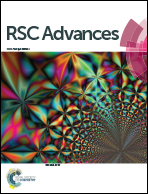Impact of inkjet printed ZnO electron transport layer on the characteristics of polymer solar cells†
Abstract
In this paper, we demonstrate that zinc oxide (ZnO) layers deposited by inkjet printing (IJP) can be successfully applied to the low-temperature fabrication of efficient inverted polymer solar cells (i-PSCs). The effects of ZnO layers deposited by IJP as electron transport layer (ETL) on the performance of i-PSCs based on PTB7-Th:PC70BM active layers are investigated. The morphology of the ZnO-IJP layers was analysed by AFM, and compared to that of ZnO layers deposited by different techniques. The study shows that the morphology of the ZnO underlayer has a dramatic effect on the band structure and non-geminate recombination kinetics of the active layer deposited on top of it. Charge carrier and transient photovoltage measurements show that non-geminate recombination is governed by deep trap states in devices made from ZnO-IJP while trapping is less significant for other types of ZnO. The power conversion efficiency of the devices made from ZnO-IJP is mostly limited by their slightly lower JSC, resulting from non-optimum photon conversion efficiency in the visible part of the solar spectrum. Despite these minor limitations their J–V characteristics compare very favourably with that of devices made from ZnO layer deposited using different techniques.



 Please wait while we load your content...
Please wait while we load your content...